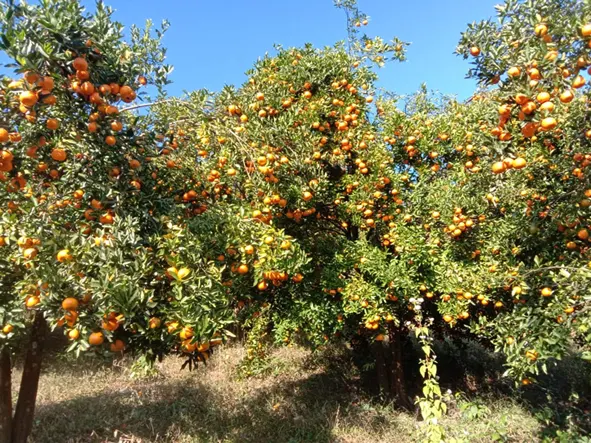[Karyir Riba]
Dambuk, a small town in Lower Dibang Valley (LDV) district of Arunachal Pradesh, does not require an introduction. One of the most picturesque places in the state, it is well known to travellers all across the country and hosts visitors throughout the year.
This was not always the case. Before proper road connectivity was established to and from Dambuk (Dibang bridge in 2018 and Sissiri bridge in 2019), it was just another unexplored beautiful town nestled in some corner of Arunachal. Today, Dambuk has potentially become a tourism hub and is highly flourishing.
One of the most significant contributors to the growth and development of Dambuk are its oranges. In fact, Dambuk has rightfully acquired the moniker ‘The Orange Bowl of Arunachal’. The beautiful orange gardens add to the beauty of the place, especially during fruiting season, when the systematically lined orange trees, laden with orange oranges (no pun intended) create a breathtaking sight.
Most of Dambuk subdivision is dedicated to orange gardening, with hills to backyards of houses adorning beautifully spaced and lined orange trees. So one can only imagine how gorgeous the place looks during the orange season. The closest comparison one can think of is to a town full of fully decorated Christmas trees with twinkling lights and all.
Locals selling their plump oranges outside their gates, on the sides of the road all along the NH 13 stretch in the region make a lovely sight and give you an indescribable sense of pride. A part of the Roing bazaar turns orange in colour and seems more vibrant than usual.
Apart from adding to the beauty of the area, oranges hugely contribute to the economy of Dambuk subdivision. To quote GB Budi Pertin, a prominent orange farmer of the area, “Dambuk’s traditional kutcha houses have developed into RCC buildings with GC sheet roofing only because of its oranges.”
Year after year, Dambuk has not only tended to the longing of orange lovers in LDV, but has been fulfilling the demands of oranges in different parts of the country. These sweet and juicy organic wonders of Dambuk have also seen international fame as they were exported to Dubai and Muscat in 2022. Earlier, in 2018, Dambuk oranges were also procured in a huge number by the Spice Fresh Pvt Ltd, which exports to the global markets of the Gulf Corporation Council, South East Asia, the European Union, and others.
2023, though, has not been too kind to Dambuk and its orange growers. Sadly, this year, the orange trees are all empty and barren even in the peak season. The once scenic hills with orange laden trees are looking dry and lifeless. There are still a few oranges being sold in the market but the juicy and sweet-tasting oranges have been replaced by dry and spongy textured, tasteless oranges, which are not at all close to the quality Dambuk once produced.
Meeting with a few of the prominent orange farmers of the area answered all the questions. The orange gardens of Dambuk are dying, one after the other.
Orange farmers Atek Linggi, Budi Pertin, Attong Pertin, Ajoy Libang, Perkom Linggi, Jamoh Linggi, Tana Mena and Raan Linggi are a few of the many farmers who have been growing oranges since a very long time, some almost for the last four decades.
“We had seen our grandfathers and fathers grow oranges. We saw them earning a living out of their orange gardens. We got into the same with the thought that our orange gardens would take care of our families just as they did for our fathers. But the situation has gone from bad to worse now. Our trees are dying and we are unable to do anything to save them,” they said.
According to the farmers, the last three years have been the worst for them, and this year all their hopes have died along with their trees. Orange farming is the main source of income for many in the region, and without any technical support/remedy for what is happening to their orange trees, these farmers are extremely dejected and demotivated at the moment.
So, what exactly is happening to these orange trees? Well, the farmers are frustrated because they do not know what they are fighting against. “The leaves start to turn yellow and, within a short span of time, the tree starts to die. The very few fruits that these trees produce are small, dry, and taste bad,” they informed.
Orange farming requires a lot of maintenance. From regular cleaning to proper watering, it is a task to upkeep a thriving garden and requires immense hard work. The season from May to October requires extra care as the trees tend to get infested by insects. The farmers have learnt to keep the insects at bay and have saved their trees without much trouble all these years. However, this time around, things are different and everything they have tried has been futile.
They informed, “This disease was first seen in the orange gardens of Wakro some 4-5 years ago. Anjaw, Lohit and other districts got affected too, and three years back we started noticing it in Roing, and then in Dambuk. We have approached the horticulture department umpteen times to help us deal with the menace, but our pleas and cries have only fallen on deaf ears and blind eyes. It is a very unfortunate situation as we have been left helpless. We do not ask for money or compensation. We have never asked them for that. What we have been asking for is a remedy to stop this dreadful disease. Unfortunately, we have always been turned away without any assistance.”
It indeed is very unfortunate that these farmers are being treated so inconsiderably. How right is it to unsee and unhear the people who have made Dambuk visible on the world map?
“It’s been three years now. More years if we consider the first occurrence in Wakro. Isn’t that enough time for the authority concerned to even put in some research work if needed?” they questioned, aptly.
The farmers informed with experience that a single healthy orange tree produces near about 4,000 oranges in a single season. Once a decent sized sapling is planted, it takes anywhere between 7-10 years for it to start producing fruits. And, if kept with proper care, it keeps producing fruits till around 60 years or more.
It was really disheartening to hear them discuss that the only way they see any possibility to revive their orange gardens is to completely start afresh. Remove each and every tree and give some time to the land to replenish its nutrients, and then start planting new saplings. “That seems like the only way. But we are old and tired. We will not be able to withstand that kind of work. The young ones will be able hopefully,” said the demotivated lot.
To avoid the situation, they have been trying different ways to protect their gardens. Atek Linggi, who had around 10,000 trees in his orange gardens before this tragedy struck, tried to save his dying trees by totally trimming away the top half of his infected trees. “I thought I’d give it a try and was of the opinion that if I removed most of the top part of the trees, maybe the new branches that sprouted thereafter might grow without the infection,” he said.
Unfortunately, this technique failed too, as he showed that the leaves on the new branches are also yellowing.
What is even more frustrating for these farmers is that newly planted saplings are also starting to turn yellow, leaving them even more hopeless.
In better days, Linggi used to earn Rs 40-45 lakhs from his orange gardens alone. This dropped to Rs 26 lakhs last season, and in this season to zero rupee.
Seeing thousands of your orange trees, which you have tended to and nurtured your whole life, die before your very eyes while your hands are tied must really be a hard place to be in.
As one farmer put it, “My oldest child’s higher education was taken care of by our oranges. Now we have two more to send to college next year. I have no idea how we are going to do that. Our orange garden was our only source of income.”
All the farmers have similar stories and are in a similar situation. They have lost complete faith in the horticulture department and the state government. This seems truly justified because there has been no help or assistance extended towards these farmers by either. No action whatsoever has been taken yet.
As per the LDV district horticulture officer (DHO), “The government is well aware of the situation. Discussions are being done and studies are being conducted. But there have been no outcome. As for assistance, our department is just a mediator. We can provide help only when the government provides some assistance. Otherwise, there is not much we can do. Only technical support/advice can be provided by us.”
When asked why they have turned deaf ears to the cries for help by these aggrieved farmers, the DHO denied having been approached. “We have even conducted Seva Aapke Dwar three times in Dambuk. Nobody approached us with the issue,” he said.
Funny!
The orange farmers have always been neglected by the horticulture department. In their words, “They have never provided us with any assistance. We have witnessed bags of manures and other medicines but none of these items have reached us ever. Back in 2006 or 2007 we did receive some saplings and barbed wire. The other time, we received rubber pipes to help in the irritation process, but they were of such pathetic quality that they broke into pieces and were useless. Saplings are not provided to us under schemes. Ironically, it is provided to people who have no gardens, and it’s sad to see those saplings just go to waste. Even if any schemes are provided by the government, help and assistance have never reached us. In 2021, we had a visit from the former chief secretary, during which he had assured an assistance of one lakh rupees per hectare to orange farmers. Till date we have no information about the same. A few times, some officials have come to our gardens, only for the purpose of placing the worst quality water tanks in our gardens and taking photographs with us and the tanks. That’s all, no awareness programmes or workshops. Local legislators and public leaders should have lent us their ears and should have been helpful. It’s sad and frustrating.”
Pointing at the dead orange trees, the farmers proclaimed that those trees had once helped them look after their families but today are mere firewood, with no chances of revival.
While some are still trying to save their orchards, some have just given up, which is evident from the hills filled with systematically spaced and lined dead orange trees covered in wild vines, that once glorified the picturesque beauty of Dambuk, the orange bowl of Arunachal Pradesh.




